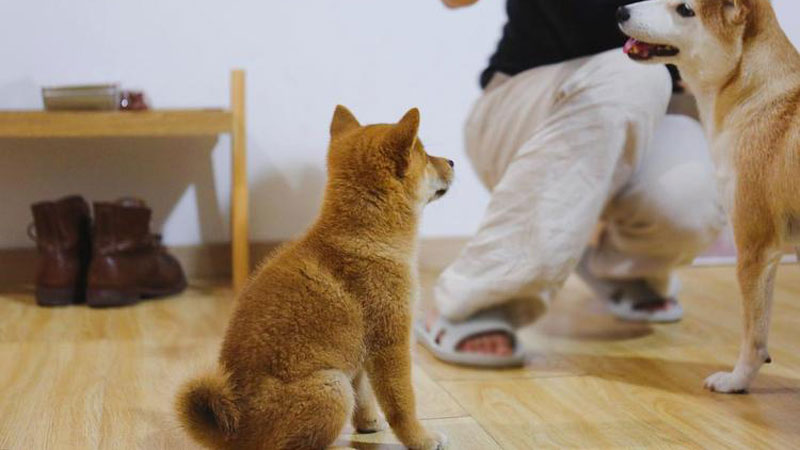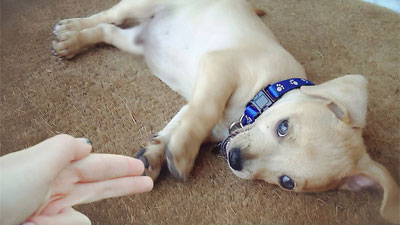- Size
- Smallest
- Small
- Small to Medium
- Medium
- Large
- Giant
- Characteristics
- Smartest
- Hypoallergenic
- Fluffy
- Best Guard
- Best Family
- Best for Kids
- Low Shedding
- Healthiest
- Police Dogs
- Most Calm
- Quietest
- Color
- White
- Black
- Grey
- Brown
- Blue
- Red
- Coat
- Hairless
- Short
- Long
- Origin
- Japan
- China
- Australia
- Germany
- Italy
- United States
- France
- Group
- Hound
- Terrier
- Herding
- Toy
- Working
- Sporting
Teach Your Dog to Sit: A Step-by-Step Guide

Training your dog to sit on command is an essential skill that forms the cornerstone of obedience training. Teaching this basic command not only establishes a communication channel between you and your dog but also fosters discipline, aids in managing behavior, and sets the stage for more advanced training. With patience, positive reinforcement, and consistency, you can guide your canine companion through the process of mastering the "sit" command.
In this article, we will outline the step-by-step process to train your dog to sit on command effectively.
Understanding the Importance of the "Sit" Command
The "sit" command is a fundamental behavior that enhances your dog's manners, facilitates control in various situations, and lays the groundwork for further training endeavors. It is a versatile command applicable in daily routines, such as when greeting guests, during walks, or before receiving meals.
Step-by-Step Guide to Teach Your Dog to Sit
Step 1: Prepare for Training
Before beginning the training process, make sure you have a suitable training area free from distractions. Have some small, soft treats on hand to use as rewards. It's also helpful to have a clicker if you have used clicker training before.
Step 2: Get Your Dog's Attention
To start training the sit command, you need to get your dog's attention. Stand in front of your dog with a treat in your hand, and say your dog's name to get its attention. Make sure you have your dog's full attention before proceeding.
Step 3: Lure Your Dog Into a Sitting Position
Hold the treat close to your dog's nose and slowly move it upwards and slightly backward, which naturally encourages your dog to look up and sit. As your dog's nose follows the treat, its backend should lower into a sitting position. Once your dog is in a sitting position, click the clicker (if using one) or say "yes" and immediately give your dog the treat. Remember to praise and reward your dog promptly to reinforce the desired behavior.
Step 4: Repeat and Reinforce
Repeat the process of luring your dog into a sitting position multiple times in each training session. Be consistent with your hand signal and verbal command. Use the same phrase, such as "sit" or "sit down," each time you want your dog to sit. Repetition and positive reinforcement will help your dog understand the command more quickly.
Step 5: Add the Verbal Cue
Once your dog starts to associate the sitting position with the luring motion, you can introduce the verbal cue. As you raise the treat, say the word "sit" right before your dog's backend touches the ground. Continue to do this until your dog starts to associate the word "sit" with the action of sitting. Remember to click or use the verbal marker and reward your dog as soon as it sits on command.
Step 6: Reduce the Lure
As your dog becomes more proficient in sitting on command, gradually reduce the lure. Begin by using an empty hand and just the verbal command. If your dog hesitates or doesn't respond, you may need to go back to using the treat as a lure and then slowly fade it out again. The goal is for your dog to respond to the verbal command without the need for a physical prompt.
Step 7: Practice in Different Environments
Once your dog understands the sit command, practice in different environments with increasing distractions. Start in a quiet, familiar area, then gradually introduce more distractions, such as other people, dogs, or noises. This will help your dog generalize the command and respond in any situation.
Step 8: Reinforce and Maintain the Training
Consistent reinforcement is crucial in maintaining the sit command. Continue to reward your dog intermittently or through praise and petting to reinforce the desired behavior. Additionally, it's essential to keep training sessions short and fun, ending on a positive note. Regularly incorporating the sit command into your daily routine will help solidify the training and reinforce good behavior.
Beyond the "Sit" Command
Once your dog has mastered the "sit" command, you can build upon this foundational behavior by introducing more advanced commands and tricks. Additionally, you can use the "sit" command as a precursor to teach behaviors like "stay," "down," or "heel."
Troubleshooting Common Challenges
Some dogs may struggle with the sit command initially. Here are some common challenges and how to address them:
Lack of Interest: If your dog is not motivated by treats, find a reward that does motivate them, such as a toy or playtime. You can also try using a different type of treat, like small pieces of cheese or freeze-dried meat.
Distractions: If your dog gets easily distracted during training, start in a quiet room with minimal distractions. Gradually introduce distractions as your dog becomes more proficient in the command.
Slow Response: If your dog is slow to respond, make sure you have their full attention before giving the command. You may also need to adjust your body language and be more clear and assertive in your command.
Jumping Up: Some dogs may have a tendency to jump up instead of sitting. In this case, turn your body slightly to the side to discourage jumping and lure your dog into a sitting position. Reward the sit and ignore any jumping behavior.
Conclusion
Training your dog to sit on command is essential for their obedience and overall behavior. With consistent training, positive reinforcement, and patience, your dog will master the sit command. Remember to start in a distraction-free environment, use a lure to teach the desired behavior, and gradually fade out the lure and introduce the verbal cue. Practice in different environments and reinforce the training regularly to ensure your dog's understanding and compliance. Happy training!
You May Also Like
 Dog Training TipsTrain Your Dog to Play Dead: A Step-by-Step Guide
Dog Training TipsTrain Your Dog to Play Dead: A Step-by-Step Guide Dog Training TipsTrain Your Dog to Roll Over: A Step-by-Step Guide
Dog Training TipsTrain Your Dog to Roll Over: A Step-by-Step Guide Dog Training TipsTeaching Your Dog the "Sitting Pretty" or "Beg" Trick
Dog Training TipsTeaching Your Dog the "Sitting Pretty" or "Beg" Trick Dog Training TipsTraining Your Dog to Spin: A Step-by-Step Guide
Dog Training TipsTraining Your Dog to Spin: A Step-by-Step Guide Dog Training TipsTeaching Your Dog to Wave Goodbye: A Step-by-Step Guide
Dog Training TipsTeaching Your Dog to Wave Goodbye: A Step-by-Step Guide Dog Training TipsTeaching Your Dog the Classic Trick: Shake Hands
Dog Training TipsTeaching Your Dog the Classic Trick: Shake Hands